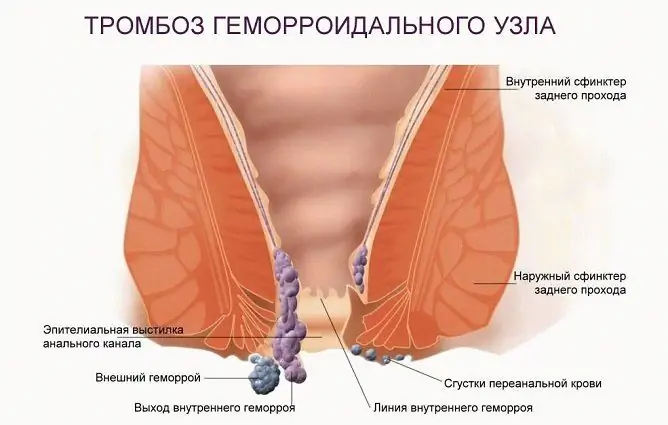- Author Rachel Wainwright [email protected].
- Public 2024-01-15 19:51.
- Last modified 2025-11-02 20:14.
Complications of chickenpox
The content of the article:
-
Possible options for the course of infection in adults
- Chicken pox
- Herpes zoster (shingles)
- Clinical forms of chickenpox
- Complications after chickenpox
- Consequences of chickenpox in pregnant women
- Specific prevention
- Video
Chickenpox, or chickenpox, is included in an extensive group of acute diseases with airborne transmission. It is caused by human herpesvirus type 3. This virus causes not only chickenpox but also herpes zoster. Chickenpox is predominantly ill in childhood. Pathology in adults is rare and is usually characterized by a more severe course. The occurrence of complications of chickenpox in adults is determined by the state of immunity and the presence of concomitant pathology. Adequate and timely treatment is the key to recovery. Specific prophylaxis is carried out through vaccination.
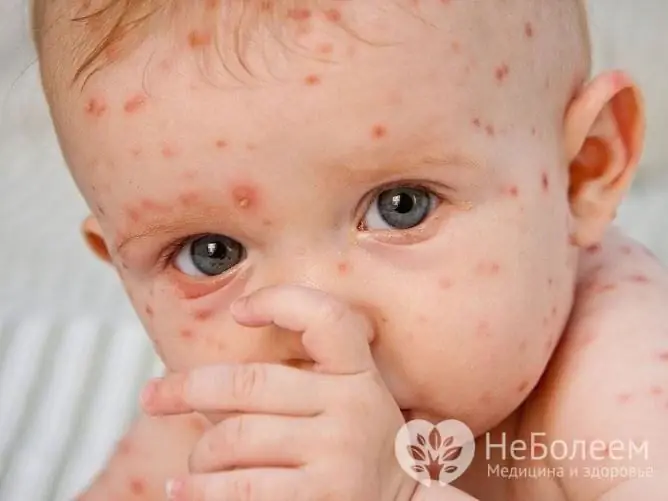
Usually, chickenpox in children is mild, but for a number of reasons, various complications can develop
Possible options for the course of infection in adults
Human herpesvirus type 3 (HHV-3, varicella-zoster virus, varicella-zoster) causes two diseases.
Chicken pox
More often children under the age of 7-10 years get sick, the course of the disease is usually mild, adults rarely get sick.
The virus, entering the body, is introduced into the mucous membranes of the upper respiratory tract, enters the bloodstream and is fixed in the skin. The temperature rises, nonspecific manifestations of infection occur: weakness, pain in the head, lumbosacral region. After 1-2 days, a rash appears on the face, scalp and torso: pink spots from 2 to 4 mm, turning after a few hours into papules (nodules), and then into vesicles (vesicles). The latter dry out after 24-72 hours with the formation of crusts that fall off at 2-3 weeks of illness.
Adults are characterized by massive rashes, severity of general toxic phenomena and severe itching. A rash can also appear on the mucous membranes of the oral cavity, conjunctiva, genitals, which is accompanied by pain and the formation of erosions. The period of temperature rise lasts from 2 to 8 days, rashes - from 2 to 7-9 days. If complications do not develop, then recovery occurs, and persistent immunity is formed.
In some cases, the pathogen can exist for a long time in the human body, and after a while it can become active and cause herpes zoster.
Herpes zoster (shingles)
When first ingested, usually in a child or adolescent, type 3 herpes simplex virus causes typical chickenpox. But in some cases, in a person who has been ill, he goes into a "sleeping" state and hides in the nerve cells for a long time, without causing any symptoms. The result of the activation of the virus under the influence of various provoking factors is the exit from the nerve cells, movement along the nerve and skin damage.
The disease begins with general weakness and hyperthermia. Along the course of the nerve trunks, more often the intercostal and trigeminal branches, first there is a slight itching and tingling sensation, and then rashes appear: pink spots that turn into nodules after 3-4 days, and after a short time - into bubbles with transparent contents. The process is accompanied by an increase in regional lymph nodes. Gradually, the vesicles burst, dry out, forming crusts. Uncomplicated herpes zoster lasts 3 to 4 weeks.
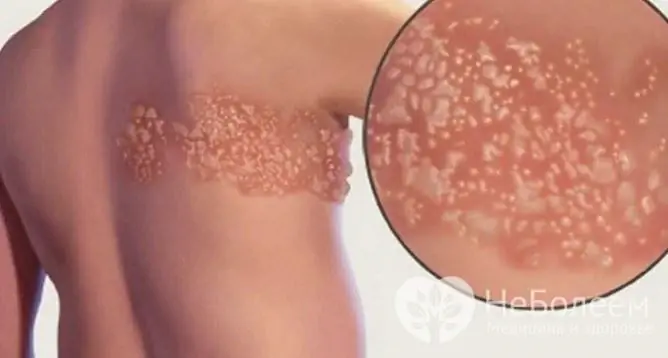
Shingles is a variant of the disease caused by the varicella-zoster virus
The typical course of chickenpox and shingles is not always observed.
Clinical forms of chickenpox
Chickenpox is usually benign. In some cases, severe clinical forms of the disease may occur.
| Clinical form | Description |
| Generalized (visceral, disseminated) | It is characterized by high fever, severe intoxication, profuse rashes on the skin and mucous membranes, and damage to internal organs. |
| Hemorrhagic | It is rare, it is recorded in persons with weakened immunity. The contents of the bubbles are hemorrhagic, or bloody. Hemorrhages in the skin and mucous membranes, nosebleeds, vomiting with an admixture of blood, hemoptysis, blood in the urine are noted. |
| Bullous (gallbladder) | Against the background of typical rashes, bubbles appear up to 3 cm in diameter with a flabby tire and cloudy contents. After opening the bubbles, weeping surfaces remain in their place. The healing process can end with the formation of brownish spots. |
| Pustular | In this type of disease, the contents of the vesicles fester. Because of this, the elements of the rash do not disappear for a long time, pigmentation remains in their place for several weeks. |
| Gangrenous (necrotic) |
A zone of inflammation is formed along the periphery of the vesicles with purulent contents. Then, in place of the blisters, scabs form, after which ulcers are found with areas of necrosis and undermined edges. |
Atypical forms of chickenpox develop against a background of weak body resistance. Factors provoking a decrease in immunity are:
- taking medications (hormones, antibiotics, sulfonamides, antifungal agents, etc.);
- excessive physical and emotional stress;
- prolonged hypothermia;
- malignant tumors;
- radiation exposure;
- professional harm;
- inadequate food ration;
- alcohol abuse, tobacco smoking.
The listed factors cause severe forms of infection in both children and adults.
Complications after chickenpox
The development of complications of chickenpox occurs due to the action of the virus itself and due to the addition of a secondary infection caused by various bacteria. The former, directly related to the herpesvirus, are usually called specific, the latter - bacterial.
| Tissues, systems and organs involved in the pathological process | Complications |
| Skin, subcutaneous fat | Streptoderma, or pyoderma (purulent skin lesions caused by streptococci); abscess (purulent inflammation of tissues with their melting and the formation of a delimited purulent cavity); phlegmon (diffuse purulent inflammation of the cellular spaces); erysipelas (soft tissue infection caused by group A beta-hemolytic streptococcus). |
| Mucous membranes | When the oral cavity is damaged, stomatitis develops, larynx - laryngitis, sometimes with signs of stenosis of the respiratory tract, eyes - conjunctivitis, ear - otitis media. |
| Respiratory system | Acute catarrhal inflammation of the upper respiratory tract, laryngotracheobronchitis, pneumonia. The course of pneumonia can be severe, with severe shortness of breath, cyanosis (bluish color of the skin and mucous membranes), sputum with an admixture of blood. |
| central nervous system | Encephalitis (inflammation of the brain), encephalomyelitis (simultaneous damage to the brain and spinal cord). Encephalitis usually develops on the 4-7th day of illness, when fever resumes, headache, vomiting, dizziness, unsteadiness of gait, impaired coordination of movements, weakness of skeletal muscles, tremors (tremors) of the extremities appear. |
In rare cases, the development of myocarditis (inflammation of the muscular membrane of the heart), arthritis (inflammation of the joints), glomerulonephritis (kidney damage) is possible.
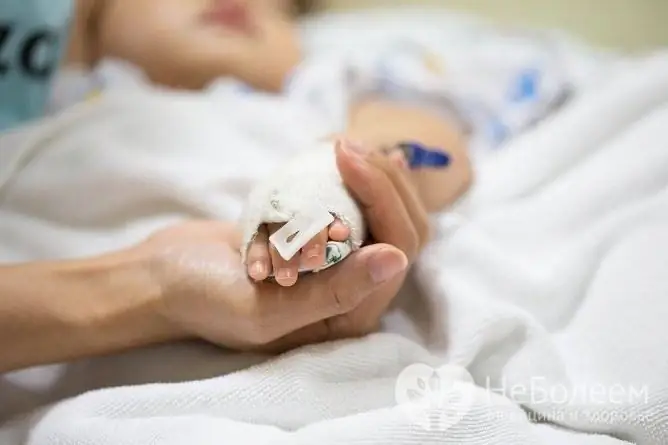
Complications of chickenpox can be varied, causing inflammation in a wide variety of organs.
Consequences of chickenpox in pregnant women
Disease of chickenpox while carrying a fetus is not an indication for termination of pregnancy. The consequences of chickenpox for the fetus depend on the period in which the pregnant woman had the infection.
| The gestational age at which the infection occurred | Consequences for the fetus |
| Up to 14 weeks pregnant | A miscarriage is possible, a teratogenic effect is an effect on the fetus that disrupts embryonic development, however, the birth of children with developmental defects due to chickenpox is very rare. With infection in this period, the risk of developing pathology in the fetus is about 0.4-0.5%. |
| From 14 to 20 weeks | The likelihood of developing pathology in the fetus does not exceed 2%. The termination of pregnancy is not noted. |
| After 20 weeks | The negative impact on the fetus is minimal, there is practically no risk for the child. The introduction of a specific immunoglobulin to a pregnant woman reliably reduces even this small probability of developing pathology in the fetus. |
| 10-14 days before delivery | The first clinical symptoms of the disease are detected immediately after childbirth. The course of the infection is usually not very severe. This is due to the fact that the mother has time to develop specific antibodies that reach the fetus through the placenta. |
| Just before childbirth | If a pregnant woman becomes ill 4-5 days before delivery or just before delivery, the child with a probability of up to 17-20% may develop a congenital form of chickenpox. Congenital chickenpox is considered all cases of a newborn's disease under the age of 11 days. Usually, clinical signs appear at 5-10 days of a baby's life. The pathology is characterized by a severe course, accompanied by bronchopneumonia, loose stools, and damage to internal organs. According to statistics, every third case of the disease ends in death. |
Specific prevention
Vaccination is a specific prophylaxis method that avoids chickenpox and herpes zoster, and hence the possible complications of these infections. Vaccination is included in the mandatory vaccination schedule in many countries and is carried out according to a certain scheme.
| Vaccine name | Terms of vaccination |
| Okavax | Children under one year old: 1 dose (0.5 ml) once. |
| Varilrix | Children from 1 year to 13 years: 1 dose (0.5 ml) twice with an interval between the first and second vaccinations of 6-10 weeks. For adolescents over 13 years of age and adults: 1 dose twice with an interval of 6-10 weeks. |
| Okavax, Varilrix, Varivax | For emergency prophylaxis, any vaccine is used: 1 dose (0.5 ml) is optimal in the first 72 hours, permissible in the first 96 hours after contact with an infected person. |
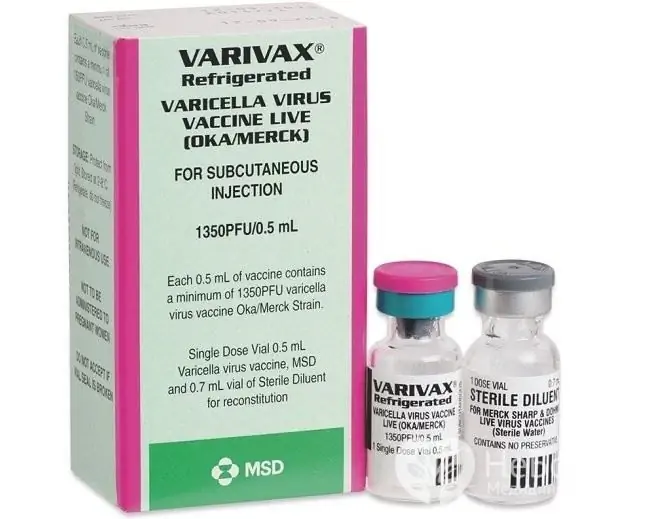
Varivax is one of the vaccines against chickenpox, shingles, and hence their complications
To prevent the development of complications of chickenpox, it is necessary to consult a doctor in a timely manner and follow all his recommendations. Considering that the nature of the course of the infection largely depends on the state of the general resistance of the body, one should lead a healthy lifestyle and abandon bad habits.
Video
We offer for viewing a video on the topic of the article.

Anna Kozlova Medical journalist About the author
Education: Rostov State Medical University, specialty "General Medicine".
Found a mistake in the text? Select it and press Ctrl + Enter.





